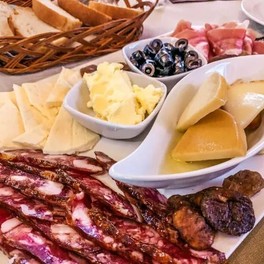What to Eat in Montenegro?
 What to Eat in Montenegro?
What to Eat in Montenegro?Montenegrin cuisine is incredibly diverse, influenced by the country's rich history and various cultures. One of the best answers to the question What to eat in Montenegro is njeguški pršut, a type of smoked meat that is particularly popular in the southern regions of Montenegro. This delicious meat is typically served with fresh bread and cheese, offering a perfect introduction to Montenegrin flavors. Meat dishes in Montenegro are commonly made with beef or lamb, which are suitable for those following Islamic dietary rules.
Another well-known dish in Montenegro is cevapi, small grilled minced meat sausages. These tasty sausages are typically served in thin flatbread, often accompanied by onions and yogurt. Cevapi are a popular street food in Montenegro, enjoyed by both locals and tourists alike. Another beloved dish is burek, a savory pastry made with thin layers of dough filled with minced meat or cheese. This dish is often enjoyed for breakfast or as a light dinner.
Seafood also plays an important role in Montenegrin cuisine, especially along the coastal areas. Montenegro's coastline is famous for its fresh seafood, and local restaurants regularly feature freshly caught fish and shellfish in their menus. One of the most popular seafood dishes is open sea bass, a flavorful fish typically grilled and served with olive oil and lemon. Other seafood, such as shrimp and mussels, are also essential parts of Montenegrin cuisine.
One of the traditional Montenegrin desserts that should not be missed is kolači, a sweet pastry often served at weddings and celebrations. Kolači are sugary baked goods made in various shapes and flavors. Additionally, Montenegrin torta desserts are typically filled with rich creams and fruits, offering a sweet treat for dessert lovers.
Finally, the Montenegrin breakfast culture is rich and varied. One of the most beloved dishes for breakfast is kačamak, a traditional dish made from cornmeal, milk, and cheese. It is often served hot in the morning and is a staple in many Montenegrin households. Especially during cold winter mornings, kačamak provides much-needed warmth and energy to start the day.
Other Contents